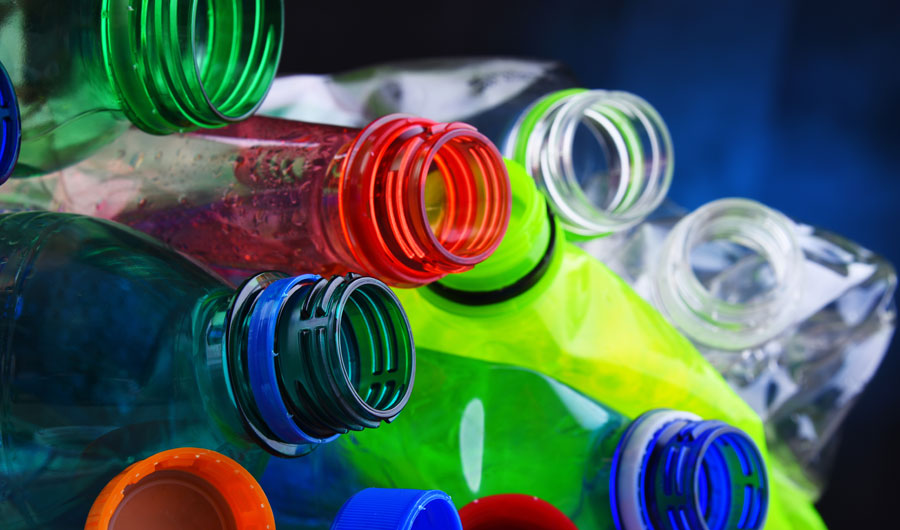A New Technique Turns Waste Plastic into Valuable Chemicals

(Inside Science) -- A novel technique can simultaneously break down the most commonly used form of plastic and synthesize valuable, widely used molecules, potentially making some plastic waste recycling more attractive and practical, a new study finds.
Roughly 300 million metric tons of plastic waste is created every year, with nearly 12 billion metric tons of such garbage expected to pollute the planet by 2050. The molecule polyethylene, often used in packaging and grocery bags, is the largest component of plastic waste, and may take many centuries to decompose, said study senior author Susannah Scott, a chemical engineer at the University of California, Santa Barbara.
One problem with plastic is that it is cheaper and easier to produce and throw away than it is to recycle. Products made from recycled plastics often possess inferior properties to newly made ones, and breaking plastics down to their original building blocks is often complex and requires a lot of energy or chemicals, so the resulting products often do not recoup the costs of processing.
One potential way to address this economic hurdle is to "upcycle" plastic waste -- to convert it into valuable chemicals. However, this often involves the energy-intensive, laborious step of breaking the plastic down to its basic components before synthesizing the desired compounds.
Now Scott and her colleagues have developed a simple, low-energy technique for converting polyethylene into alkylaromatic compounds, which are the basis of many detergents, lubricants, paints, solvents, pharmaceuticals and other industrial and consumer products and currently support a $9 billion market annually. They successfully tested their method on actual polyethylene waste consisting of a plastic bag and a water bottle cap.
"Polyethylene is one of the most used and produced plastics in the world -- there is an enormous waste stream available," said Bert Weckhuysen, a chemical engineer at Utrecht University in the Netherlands, who did not participate in this study but wrote a perspective article on the research for the journal. "They are able to turn a low-value product into a high-value product."
Only moderate temperatures are required -- whereas conventional methods for manufacturing alkylaromatics typically demand temperatures of 500 to 1,000 degrees C (about 930 to 1,830 degrees F), this new process just needs about 300 degrees C (roughly 570 degrees F). It also does not call for water or any other solvent -- it simply requires cooking polyethylene with a common kind of catalyst made of platinum nanoparticles on alumina grains, long used in oil refining.
This new strategy relies on two different chemical reactions that operate in tandem. One uses hydrogen to cut polyethylene apart into smaller pieces, breaking the strong molecular bonds holding the plastic together, whereas the other synthesizes alkylaromatic compounds. The latter reaction generates hydrogen that can help drive the former reaction. Only a small quantity of byproducts is created -- light gases such as methane, which can be burned to help provide energy to run the process.
"The most surprising finding is that polyethylene is actually a better starting point for making alkylaromatic molecules than the usual starting point, which is molecules that come directly from oil," Scott said. This new method for creating alkylaromatics requires much less heat than conventional methods, she explained.
"In this sense, using plastic is not second-best, but actually preferred, and it gives a new way to look at the value of plastic waste," Scott said. "We are reminded that plastics are highly engineered and processed materials whose energy and chemical content represents an opportunity rather than a disadvantage to overcome."
One drawback of this new technique is that the catalyst does lose activity over time as matter gloms onto it. However, Scott noted that one could refresh it by, say, heating the catalyst in the presence of air to burn off anything stuck on the surface.
Although the catalyst is itself expensive, "its cost is amortized over the enormous amount of product it can generate over many years," Scott said. Weckhuysen noted future research can explore developing cheaper alternatives.
Future research could not only explore ways to make this catalyst more effective, but also investigate different catalysts that can break down other plastics or generate other valuable products, Scott said. This could help pave the way toward a future where plastic is not considered waste but rather a valuable raw material, Weckhuysen said.
The scientists detailed their findings in the Oct. 23 issue of the journal Science.

